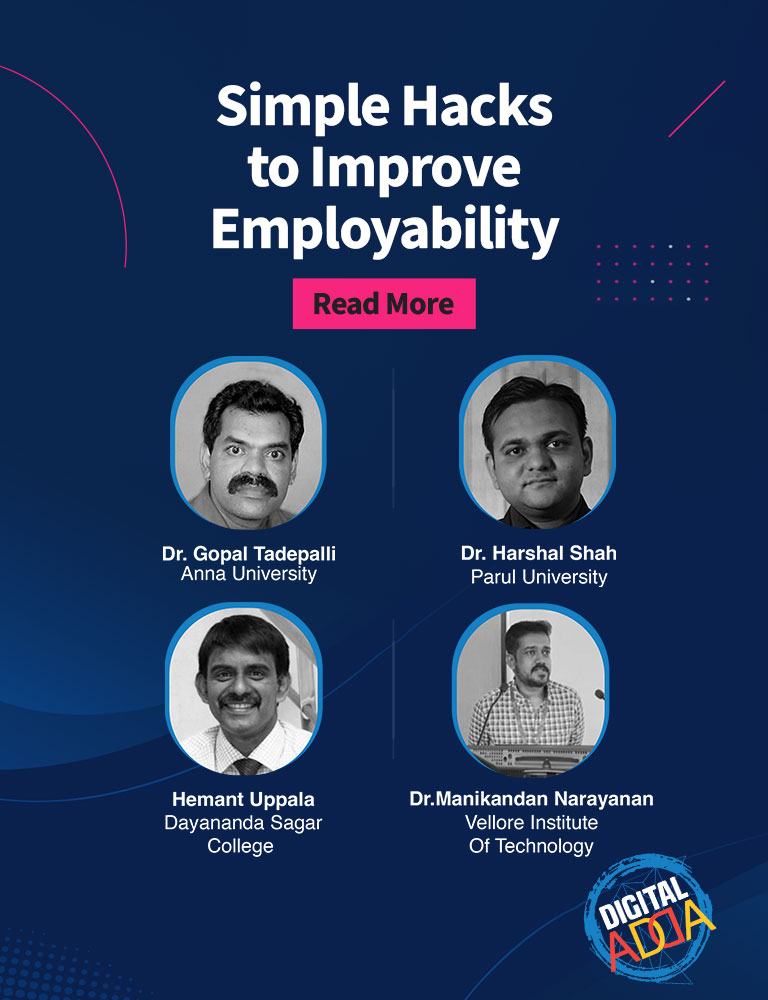Simple Hacks to Improve Employability
- Professional Skills
Resume writing is passe!
Says who?
Speaking at NASSCOM FutureSkills Prime’s Digital Adda round table session, Dr. Harshal Shah, Parul University shared that these days students are taking up additional certifications on specific technologies. Once they share their credentials on social media, it is recruiters who approach them with job offers. Businesses need digitally skilled talent. You just need to show them that you have it.
As part of the mission to prepare industry ready talent, FutureSkills Prime organized a virtual round table – “Digital Adda”, as we call it, to discuss with eminent academics how students are recruited and what they can do to get an edge over competition.
Dr. Gopal Tadepalli, Anna University, gave a very interesting analogy. Quoting the example of Vishwakarma who built the city of Dwarka, he said that it is when head, heart, and hands all work in tandem, it shows the competency of an individual. Students should aim to direct these competencies towards a skill, for which a need is perceived, while identifying the skills required from the next three months up to the next five years.
How to choose the right course and right mode:

With a plethora of MOOC options available, how should a student choose which course to consume?
For this, students need to identify the kind of learner that they are.
Are you an applicative, visual learner or are you a kinesthetic* one? Do you learn best by reading/writing what you learn? Decide and choose accordingly.
Dr. Manikandan, Vellore Institute of Technology (VIT) advised, if as part of college curriculum, you are learning python, choose an advance level Python MOOC Course; thus, aligning your learning and giving direction to your career path. If you are a second-year student, opt for any one simulation tool in your area of interest. Basically, choose one level up from whatever you are learning in college curriculum. Typically, recruiters check which programming language you know, based on that the simulation tool and process automation tool you can use and how well you can apply in practical life.
Did you know that even some organizations like Pearson VUE maintain repositories of candidates who have cleared their courses, assessments and got certifications. There is a particular organization that maintains a database of candidates who cleared their foundation, Associate and then Specialist certificates. Talent hunters these days keep track of these repositories and look closely at a candidate’s social media profile. If you have a certification and are skilled in a particular technology, go ahead and put it in your LinkedIn profile. That is one way to get recruiters to take notice.
Other Benefits of Certifications:
You wouldn’t want to be seen as one step behind when it comes to the latest technologies and trends. Certifications help to keep you up to date and in tune with the times.
Certifications validate a candidate’s knowledge and skills. Not just that it also earns them respect from their peers.
Build your skills in a particular domain. Focus on creating a core professional identity. Demonstrating multiple certifications in a particular area, showcasing your learning journey from beginner to advance d to expert, gives you a chance to become a subject matter expert (SME) even as you are still studying. Build your network in your area of expertise. Join communities.
Best Practices:
Vellore Institute of Technology (VIT) is offering two credits for SSC certified candidates. You don’t have to wait to learn stuff in the classroom. Infact Dr. Manikandan, VIT, shared that some organizations are even offering higher packages to certified candidates.
Talking about the FutureSkills Prime, Prof Hemanth Uppala, Dayanand Sagar Institute, shared that it is not just students but also faculty who can use it to upskill in emerging technologies.
Actionables:
- Quality of assessments of MOOC courses needs to be looked into.
- The academic institution should display trust in MOOCs to prevent high dropout rate. Another suggestion was to incentivize students with credits to ramp up motivation to take up and complete these courses and take the assessments.
- Choice based curriculum: Certification should be positioned in a manner that it should lead to specialization that tells that the particular student has a specialization in CS, or ME and should retain core professional identity.
Conclusion: Benjamin Franking said famously, “If you fail to plan, you are planning to fail.” Today the onus of learning is on the student. They need to focus on learning fundamentals thoroughly and keep that learning component with them throughout their life. Along with that the ability to demonstrate skills is important. The real deal is how the student applies their learning and knowledge in day-to-day life to solve real world problems, whichever career path they choose.
Key Takeaways:
- Businesses need digitally skilled talent. Students need to not only learn digital skills but also be able to demonstrate them.
- Students need to identify the kind of learner that they are.
- Pick one area and become an expert in that. For example, if you chose Cloud computing, focus on that. Start with a basic certification before moving onto a basic, advanced and deep skill certification in the same area.
- Build your network in your area of expertise. Join communities.
- Talent hunters these days keep track of these repositories and look closely at a candidate’s social media profile.
* Kinesthetic learning, or tactile learning is a learning style in which learning takes place by the students carrying out physical activities
Watch full video here-https://www.youtube.com/watch?v=jfxXu1TU6B8&t=491s&utm_source=SimpleHackstoImproveEmployabilityBlog_HyperlinkedWord&utm_medium=blog&utm_campaign=SimpleHackstoImproveEmployabilityBlog_HyperlinkedWord


